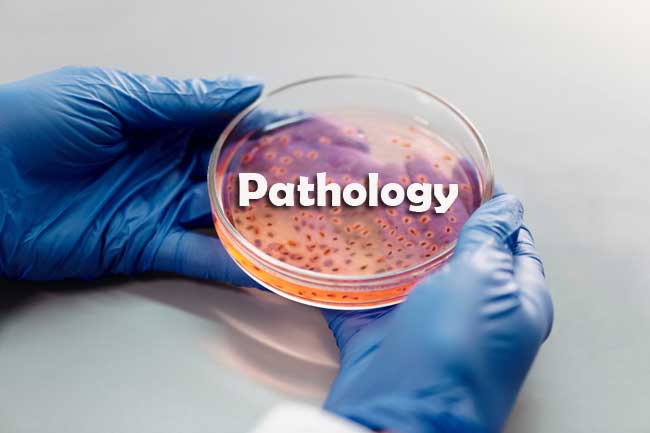Pathology Quiz
Pathology quiz Papers are available here to download for free. The candidates who are preparing for oral pathology quiz and in search for preparation tips & pattern to prepare for the written exam.

Applicants can get renal pathology quiz Papers & basic pathology quiz Pattern, oral pathology quiz Syllabus from our website. You can also download the general pathology quiz Questions with answers for free. We have provided the liver pathology quiz Papers to give proper guidance for the aspirants who are preparing for liver pathology quiz test.
Quiz on Pathology
1. Which of the following is known as Guardian of genome ?
(1) p53
(2) PTEN
(3) ATM
(4) MDM 2
2. Cells most sensitive to hypoxia are
(1) Myocardial cells
(2) Neurons
(3) Hepatocytes
(4) Renal tubular epithelial cells
3. Fibrosis is due to
(1) TGF-β
(2) IL-7
(3) IL-10
(4) VEGF
4. Leiden factor is
(1) Factor VI
(2) Factor IV
(3) Factor VII
(4) Factor V
5. Macroglossia is seen in
(1) Amyloidosis
(2) Folic acid deficiency
(3) Iron deficiency
(4) Motor neurone disease
6. Lines of Zahn occur in
(1) Coralline thrombus
(2) Embolus
(3) Infarct
(4) Post Mortem Clot
7. Basement membrane consist of
(1) Type I collagen
(2) Type II collagen
(3) Type III collagen
(4) Type IV collagen
8. Tubercle bacilli in caseous lesions are best demonstrated in
(1) Caseous centre
(2) Margin of necrosis with viable tissue
(3) Epithelioid cells
(4) Langhans’ giant cells
9. Transudate differs from exudate in having the following, except :
(1) No inflammatory cells
(2) Low protein content
(3) Low specific gravity
(4) Low glucose content
10. Granuloma is formed by
(1) Neutrophil
(2) Cytotoxic cell
(3) Helper T cell
(4) NK Cells
11. HIV is which type of virus ?
(1) Pox virus
(2) Herpes virus
(3) Picorna virus
(4) Retro virus
12. The causative organisms of plague are
(1) Yersinia pestis
(2) Haemophilus ducreyi
(3) Bordetella pertussis
(4) Pseudomonas aeruginosa
13. Malignant cerebral Malaria caused by
(1) P. vivax
(2) P. falciparum
(3) P. ovale
(4) P. malariae
14. Elevation of carcinoembryonic antigen (CEA) level is seen in
(1) Liver Cell Cancer
(2) Ovarian Cancer
(3) Breast Cancer
(4) Carcinoma of Colon
15. In Good pasture disease, the antigen is
(1) Basement membrane collagen IV
(2) Bacterial products
(3) Cationic products
(4) DNA
16. Most common paraneoplastic syndrome associated with squamous | cell carcinoma of Lung :
(1) Hypercalcemia
(2) Cushing syndrome
(3) Carcinoid syndrome
(4) Hypoglycemia
17. Most common tumour of Heart is
(1) Leiomyosarcoma
(2) Myxoma
(3) Fibroma
(4) Rhabdomyosarcoma
18. Popcorn cell seen in which type of Hodgkin’s Lymphoma ?
(1) Nodular Sclerosis type
(2) Mixed Cellularity type
(3) Lymphocyte predominance type
(4) Lymphocyte depletion type
19. Chronic gastritis is caused by all, except :
(1) Alcohol
(2) Overuse of salicylates
(3) Helicobacter pylori
(4) Pernicious anaemia
20. Mallory bodies seen in
(1) Primary biliary Cirrhosis
(2) Hepatitis C infection
(3) Post necrotic cirrhosis
(4) Amebic liver abscess
| Mock Test | Practice Set |
| Important Questions | Quiz |
| Sample Papers | MCQ |
| Model Question | Questions and Answers |
21. Kimmelstiel-Wilson lesion is characteristic of :
(1) Diabetic nephropathy
(2) HIV nephropathy
(3) Malignant Hypertension
(4) Renal Cell Carcinoma
22. In 50-80 percent cases of acute appendicitis, the inflammatory lesion initiated by
(1) Bacterial infection
(2) Luminal obstruction
(3) Viral infection
(4) Ischemia
23. Malakoplakia of Urinary bladder is a form of
(1) Dysplasia
(2) Metaplasia
(3) Papillary hyperplasia
(4) Chronic inflammation
24. Heubner arteritis is
(1) Endarteritis Obliterans
(2) Cerebral Syphilitic arteritis
(3) Hypersensitivity vasculitis
(4) Giant cell arteritis
25. Curschmann spirals are seen in
(1) Chronic Bronchitis
(2) Bronchiectasis
(3) Bronchial Asthma
(4) Wegner’s Granulomatosis
26. Type of Emphysema associated most often with a-1 antitrypsin deficiency is
(1) Panacinar Emphysema
(2) Distal Emphysema
(3) Centrilobular Emphysema
(4) Irregular Emphysema
27. The most common Lung cancer in women and non-smokers is
(1) Small Cell Carcinoma
(2) Squamous Cell Carcinoma
(3) Adenocarcinoma
(4) Large Cell Carcinoma
28. Lichen Planus is characterized by following, except :
(1) Lymphocytic infiltrate at damoepidermal junction
(2) Resolution of Basal layer
(3) Presence of elongated and broad rete ridges
(4) Presence of Civatte bodies
29. Patients of AIDS have the following type of oral leukoplakia :
(1) Speckled
(2) Hairy
(3) Nodular
(4) Wrinkled
30. Bilaterally Symmetrical Contracted Kidney is seen in
(1) Nephrosclerosis
(2) Chronic Pyelonephritis
(3) Chronic Glomerulonephritis
(4) End stage renal disease
31. Cowdry body seen in
(1) Astrocytes
(2) Neuron
(3) Oligodendroglia
(4) Microglia
32. Seminoma is a
(1) Benign tumour
(2) Borderline tumour
(3) Malignant tumour
(4) Locally aggressive tumour
33. Caplan’s syndrome may develop in the following types of pneumoconiosis, except :
(1) Berylliosis
(2) Asbestosis
(3) Coal-Worker’s pneumoconiosis
(4) Silicosis
34. Crohn’s disease is characterised by the following histopathologic features, except :
(1) Stricture formation in chronic cases
(2) Widening of submucosa due to oedema
(3) Superficial mucosal ulceration
(4) Non-caseating sarcoid like granulomas
35. Marker of level of progressive liver damage in case of hepatitis B is
(1) IgG anti HBs
(2) Anti HCV antibodies
(3) HBV DNA
(4) HBc Antigen
36. Psammoma bodies are found in
(1) Follicular Carcinoma Thyroid
(2) Adenocarcinoma Breast
(3) Adenocarcinoma Stomach
(4) Serous ovarian tumour
37. Paget’s Disease has a risk for
(1) Osteoma
(2) Osteosarcoma
(3) Fibrosarcoma
(4) Fibroadenoma
38. Osteoclasts are stimulated by
(1) Calcitonin
(2) Parathyroid hormone (PTH)
(3) Estrogen
(4) Thyroxin
39. The following types of carcinoma of the Breast is characterized by Single file pattern of tumour cells :
(1) Infiltrating duct carcinoma
(2) Invasive lobular carcinoma
(3) Medullary Carcinoma
(4) Tubular Carcinoma
40. BRCA 2 not associated with
(1) Breast cancer
(2) Pancreatic cancer
(3) Ovarian cancer
(4) Vulval cancer
41. Which of the following is post inflammatory pseudotumour of Ear ?
(1) Otosclerosis
(2) Cholesteatoma
(3) Chondrodermatitis nodularis
(4) Paraganglioma
42. Molluscum Contagiosum caused by
(1) Human Papilloma Virus
(2) Pox Virus
(3) Herpes Simplex Virus
(4) Ebstein Bar Virus
43. Conn Syndrome is
(1) Chronic hypercortisolism
(2) Secondary hyperaldosteronism
(3) Primary hyperaldosteronism
(4) Adrenogenital Syndrome
44. Strap Cells in histopathology are seen in
(1) Rhabdomyosarcoma
(2) Rhabdomyoma
(3) Histiocytoma
(4) Leiomyosarcoma
45. Sjogren’s syndrome produces the following pathological change in the eye
(1) Uveitis
(2) Glaucoma
(3) Keratoconjunctivitis
(4) Phthisis bulbi



